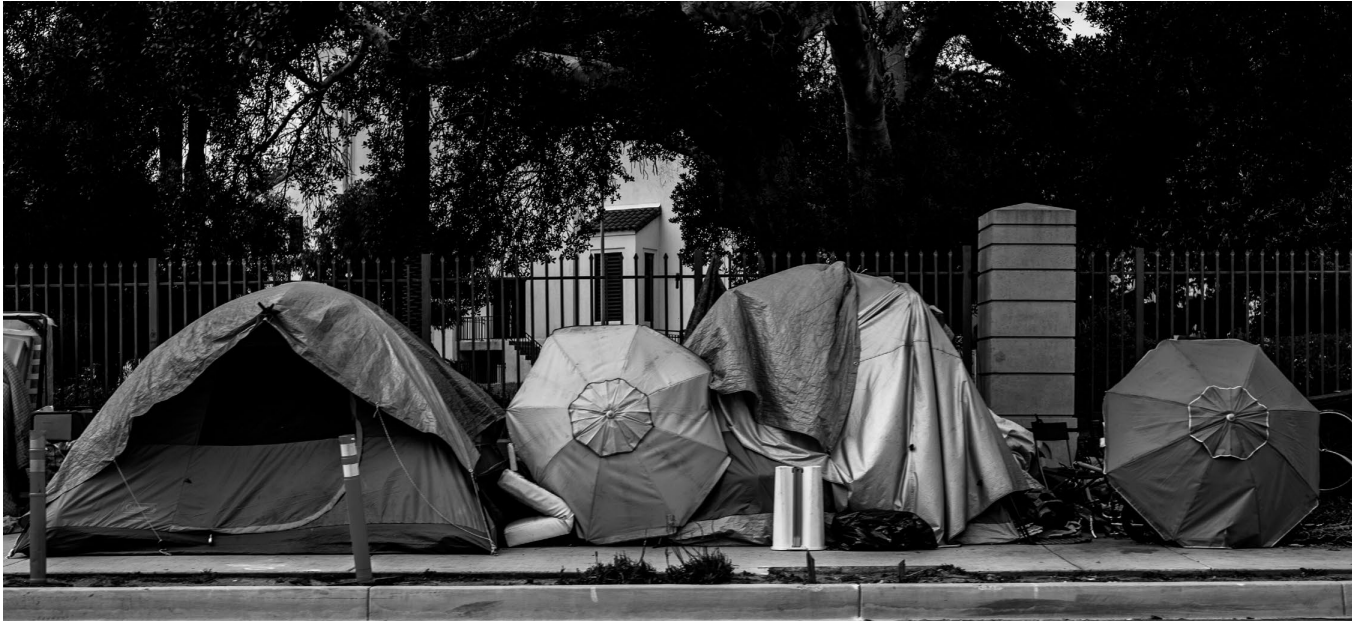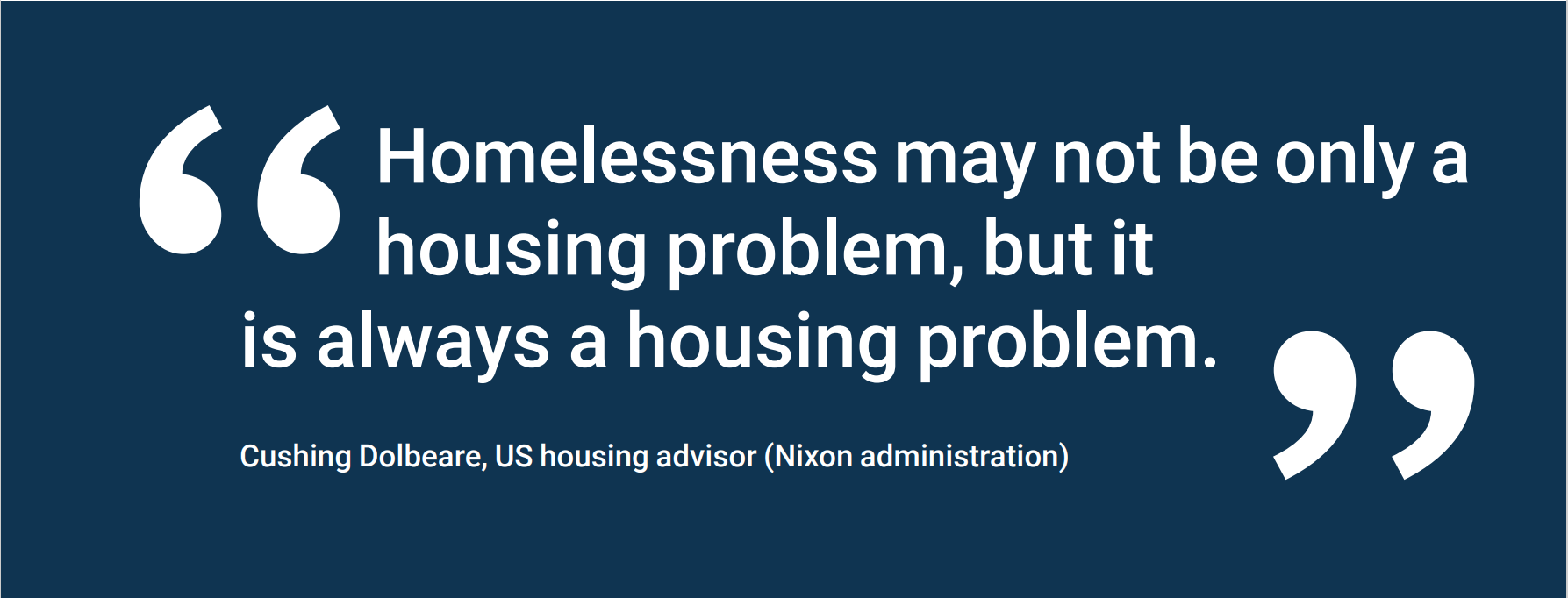Unpacking the Affordable Housing Crisis
Posted February 14, 2024
This summary of the affordable housing crisis is compiled by Linh Bui from the Institute for Community Prosperity’s three most recent annual Scans.
A report by Scotiabank on housing affordability revealed that over 10% of Canadian households, equating to 1.5 million individuals, were in 'core housing need' as per the 2021 census, with an additional quarter of a million Canadians experiencing homelessness. 1 This crisis has not only led to a rise in shelter use and unstructured encampments in the large cities, but has also spurred encampments in medium and smaller cities, a phenomenon unfamiliar to Canada since the Great Depression of the 1930s. 2

The factors contributing to this crisis are largely systemic, having evolved over the last few decades, exacerbating the challenges faced by both potential homeowners and renters alike.
These factors include:
- High inflation, coupled with high interest rates
- Rising rents
- Conversion of rental stock
- Increased immigration levels
- A lack of tradespeople
- The lack of nonprofit and cooperative housing
- A growing income divide
- Intersecting factors
- Minor factors such as NIMBY (not-in-my-backyard) attitude, the conversion of housing into Air BnB and other short-term vacation rental properties, and cumbersome approval processes and land use restrictions in some jurisdictions
Some of these factors are covered in more detail in this post. (To read in full explanations of all those factors, read the 2024 Environmental Scan, page 31)
Homeownership imbalance and intergenerational wealth transfer
Home equity has become a significant source of capital gain and a predominant strategy for retirement planning, particularly for those fortunate enough to be in the housing market. However, this has resulted in a stark imbalance, with many individuals shut out of homeownership entirely, especially in major urban markets. The intergenerational transfer of wealth, primarily from Boomers to Millennials (mostly), further widens the gap, enabling a select few privileged first-time homebuyers to enter the market with substantial down payments, thereby inflating costs. This is coupled with the speculative aspects of homebuying, whether amped up through blind bids (which may not affect prices overall, that can harm inexperienced purchasers, and is susceptible to the shady realtor practice of phantom bids).3 Well over a third of those under 40 have given up looking to buy a home altogether, rising to over 40% in the West. 4
Despite federal measures to restrict foreign ownership (check out the ‘federal government responses’ section below), domestic speculative purchasing, including in cities like Calgary, remains a significant driver of market volatility.

Cultural bias and public perception
Adding to this ownership unattainability angst is Canadians’ strong cultural bias against rental. The prevailing notion equates personal worth with property ownership, viewing renting as a transitional phase and homeownership as the pinnacle achievement. Tax policies prioritize homeownership over renting, while tenant-landlord laws often favor landlords, facilitating tenant eviction. Zoning regulations often perpetuate economic segregation and may even prohibit rental properties altogether. In sharp contrast, renters make up the majority of citizens in such prosperous countries as Switzerland, Austria and Germany. 5
"The popular belief that individual property ownership is the mark of a person’s character and worth" - A system analysis of Affordable Rental Housing Crisis in Toronto https://www.mapthesystem.ca/2020
Public perceptions of homeless individuals and renters pose significant systemic barriers. Many community groups express objections using phrases like "preserving neighborhood character" or "not against affordable housing, but not here." 6 These objections often hinder the creation of denser housing and public transportation improvements, with increasing recognition of their underlying racism and classism 7. This contributes to underinvestment in "missing middle" housing types like duplexes and triplexes. Initiatives like the federal Accelerator Fund aim to combat these barriers by promoting densification, tackling NIMBYism (Not in My Backyard), and encouraging transit-oriented development 8. Encouragingly, some communities are actively challenging NIMBYism through campaigns like Yes! In My Backyard (YIMBY) Guelph–Wellington, which aims to eliminate homelessness while promoting community involvement in solutions and debunking harmful myths. 9
Homelessness
According to the Canadian Observatory on Homelessness, at least 235,000 Canadians experience homelessness in a given year, with 25,000 to 35,000 - the population of fans at a Labour Day classic - on the streets on any given night. 10 While there are many complex pathways to homelessness, in most instances homelessness is fundamentally an issue of income inadequacy – i.e. poverty.
As well, as the Homeless Hub points out, vulnerable people turn to the homelessness sector for support when other systems fail: “Examples of systems failures include difficult transitions from child welfare, inadequate discharge planning for people leaving hospitals, corrections, and mental health and addictions facilities, and a lack of support for immigrants and refugees.” 11 Domestic violence also renders people homeless.
Intersecting factors like rising food prices, tuition costs, energy and utilities charges, and auto insurance (the latter two particularly pronounced in regulation-averse Alberta), affect students and older adults especially, both with limited disposable incomes.

Government Responses
Federal government
After decades of under-investment in subsidized housing, more accurately characterized as outright neglect, relative to other developed economies, the federal government is re-establishing actual policy goals and funding targets to “end chronic homelessness”. The Appointment Canada’s first ever Minister of Housing in 2021 is an encouraging start, as is the articulation of a rights-based approach to housing: The 2019 National Housing Strategy Act “recognize(s) that the right to adequate housing is a fundamental human right affirmed in international law”, 12 noting that such a right is enshrined in Chapter 11 of the International Covenant on Economic, Social and Cultural Rights 10
Recently, the federal government in its fall Economic Update announced $15 billion in loan funding for new rental housing construction, starting in 2025, a GST rebate to developers of rental and co-op housing to help reduce upfront costs and incentivize construction, and an incremental investment of $1 billion toward the Affordable Housing Fund over three years to support nonprofit, co-op, and public housing providers. The Affordable Housing Fund money will not start flowing until 2025-26 (assuming there is no election in the interim), with the aim of building more than 7,000 new homes by 2028 (which, it must be stressed, is less than half the annual rate of new home construction in the nonprofit and co-op sector in each of the years between 1973-1994). More symbolically – though in the longer term perhaps more meaningfully – the federal department of Infrastructure now has “Housing and Communities” added to its name and mandate. Meanwhile, the province has announced only $16 million so far for affordable housing, and only for high priority repairs to existing provincially-owned housing stock.
Historically, the federal government’s involvement tended to focus on demand-side tools, administered through the Canada Mortgage and Housing Corporation (CMHC). The Home Buyer’s Plan is a good example of this, allowing first-time home purchasers to use their RRSPs toward a down payment. There is also now a Home Buyer’s Incentive, in which the government helps with the down payment and in exchange has an equity stake in the value of the home. Other demand-shaping strategies include taxes and other restrictions on non-owner-occupied foreign ownership.
However, after years of calls from affordable housing advocates, former Minister of Housing Ahmed Hussen has acknowledged that demand-side solutions are no longer enough. Supply side actions are desperately needed; We need substantially more new housing stock in most markets, including owner-occupied, cooperative, rental and subsidized categories. As part of this, a $4 billion Housing Accelerator Fund aims to help increase the capacity of non-profit organizations and municipalities to reach a collective target of “100,000 new middle-class homes”, as well as a “rent-to-own” program (details pending). But there is a long way to go: Canada has the lowest proportion of subsidized rental of all OECD countries. 5 While these are encouraging steps, it’s not at all clear that this adds up to an adequate set of measures, considering that Canada’s previous national housing program, eliminated nearly three decades ago, added 20,000 units per year of subsidized housing for low-income people.
In addition, with much fanfare the federal government put in rules delimiting foreign ownership, but while these measures have had some positive impact, they are likely insufficient. Moreover, the government did so without reference to domestic financialization. Even the Calgary market is now heavily impacted by domestic speculative purchasing, as anywhere between 50% and 70% of October, 2022 condo sales in Calgary were to purchasers – large and small - based in Ontario. 13 As evictions are the natural corollary of financialization, we can expect increased demands locally for rent control, something that was once unthinkable in Alberta.
Current federal government responses
Recently, The federal government in its fall Economic Update announced $15 billion in loan funding for new rental housing construction, starting in 2025, a GST rebate to developers of rental and co-op housing to help reduce upfront costs and incentivize construction, and an incremental investment of $1 billion toward the Affordable Housing Fund over three years to support nonprofit, co-op, and public housing providers. The Affordable Housing Fund money will not start flowing until 2025-26 (assuming there is no election in the interim), with the aim of building more than 7,000 new homes by 2028 (which, it must be stressed, is less than half the annual rate of new home construction in the nonprofit and co-op sector in each of the years between 1973-1994). More symbolically – though in the longer term perhaps more meaningfully – the federal department of Infrastructure now has “Housing and Communities” added to its name and mandate. Meanwhile, the province has announced only $16 million so far for affordable housing, and only for high priority repairs to existing provincially-owned housing stock.
Provincial government
Despite widespread attention across Canada, housing is actually a provincial responsibility. But you wouldn’t know it from the anemic provincial response to the affordable housing crisis. In Alberta, the Ministry of Seniors and Housing offers support through various programs, but over 24,000 Albertans remain on affordable housing waitlists. 14 The Alberta government is investing $21.5 million to address capacity issues in shelters and has launched a task force on homelessness. 15 Additionally, Alberta plans to add 25,000 affordable housing units through its Stronger Foundations 10-year strategy, although concerns have been raised about potential decreases in supply due to proposed legislation. 16
Municipal government
As Calgary faces particular challenges, with only 3% of its housing market being affordable, increasing affordable housing construction is essential. 17 However, it is constrained by the municipal governments fiscal limitations (notwithstanding hundreds of millions of dollars for a new arena). The scale of new builds of affordable housing, at roughly 300 units/year over the past decade, will have to increase seven- to eight-fold to keep pace with demand. 18 Despite these challenges, the affordable housing sector in Calgary is collaborative and focused on innovation.
The City of Calgary’s Housing Strategy 2024-2030 was passed in September, after initial opposition from many members of Council concerned that it opens the door to densification city-wide. Indeed, blanket rezoning to permit townhouses and row housing in single family neighbourhoods is encouraged in the strategy, but this is following a North American trend; Because of sustainability and affordability drivers, most larger US and Canadian cities are moving away from zoning that exclusively permits single-family homes. That practice is increasingly seen as a relic of a temporary 20th Century car-centric cultural dream-time, ill-suited to a planet burgeoning with human beings.
Calgary leading the country on downtown office conversion:
As noted in last year’s scan, Calgary has led the country in downtown office vacancy rates and in conversion of office buildings to apartments. One year later, Calgary is on track to have 16 buildings fully or partially converted to residential, with more likely after a $218 million injection of federal cash. While this has helped lower the vacancy rate marginally, its main effect is to bring desperately needed vibrancy to the core. Other efforts, such as a municipal post-secondary incentive program, a blanket downtown development approval fast-track for permitted uses, and programming like the grassroots-led Lobbyfest have helped keep downtown viable. 19 Another effect of the office conversion program is incentivizing developers who were initially reluctant to come up with innovative configurations and approaches, which may well cascade into other innovation housing solutions. For example, this could be a useful prelude for uptake of the federally-funded Alberta Retrofit Accelerator among those renovating/retrofitting apartments.
Financialization
Financialization, characterized by the dominance of financial services and high levels of household debt, exacerbates housing affordability issues in Canada. 20 Easy credit and a tolerance for high levels of debt (vis-à-vis equity) has permitted households to be dangerously overleveraged, while their financial assets (ballooning mortgages in particular) are exchanged via increasingly exotic financial instruments in the money markets. Asset managers take big risks with other people’s money, mortgage lenders understate the risk of loans, and banks overextend themselves on the (probably correct) assumption that they are too big to fail.
Economists refer to these collective sets of behaviours as “moral hazards,” but social critics have also pointed out that this behaviour is consistent with “socializing risk” while “privatizing” profit. Financialization in the housing context is “a term used to describe how housing is treated as a commodity – a vehicle for wealth and investment – rather than a human right and a social good for people and communities.” Financialization has been identified as a major barrier to affordability by Canada’s first federal housing advocate, Marie-Josée Houle. 21 Marie-Josée Houle, the country's first federal housing advocate, identifies financialization as a significant barrier to affordability.
Since 1972, the federal government has allowed capital gains on home ownership to be used as a tax shelter, giving an advantage to those in hot housing markets with enough capital to invest. 22 This has led to a significant increase in housing value, particularly in consistently hot markets like BC and Southern Ontario. 23 A retired homeowner in Vancouver with the same fixed income as a retired homeowner in Fredericton will pay roughly the same in taxes, but the Vancouverite will enjoy much higher de facto income, the home equity portion of which is largely sheltered from taxation. This leads to perceptions of wealth among Canadians earning lower incomes. 22 There's growing pressure to tax windfall gains, potentially through property surcharges or capital gains on flipped houses, to address housing market overheating and support non-market housing construction, while also mitigating class-based resentment and social unrest.
As a result, financialization carries market peril. With over half of Canadian household net worth tied to residential real estate and a staggering $2.7 trillion in household debt, the housing crisis persists despite government pledges of $70 billion for a national housing strategy. Homelessness is rampant, shelter and housing waitlists are overwhelming, and tent cities are emerging nationwide. Policy failures exacerbate the crisis, as homeless-fighting strategies remain disjointed from broader affordable housing initiatives. The current federal target of 160,000 new affordable homes falls far short of meeting the demand, especially with an annual immigration target of 500,000. As one analyst notes, “three-quarters of Canada’s national wealth is real estate, and principal residences constitute a large part of that.”24 “A tax on the proceeds of principal residence sales would directly hit homeowners who, for decades, have shifted savings from other investment vehicles to their homes.” Boomers and Gen Xers have come to rely on housing as an investment (free of capital gains on their principal residence); and with returns that vastly exceed RRSPs, mutual funds, and other capital investments (whether tax-sheltered or not)
Financialization is diminishing the affordable housing stock, at a time when public policy aims to increase affordable supply. Financialization, driven by Real Estate Investment Trusts (REITs) and large financial firms, has led to the control of over 70% of Canada's purpose-built rental housing. These entities prioritize profit maximization, often at the expense of affordability for low-income tenants. During the pandemic, this trend accelerated as real estate became a preferred investment, resulting in rent increases and displacement of vulnerable renters. Approximately one-third of seniors' housing and 20-30% of purpose-built rental buildings have been financialized, exacerbating affordability and tenure insecurity. Moreover, financialization contributes to the demand for long-term care due to housing insecurity, leading to higher mortality rates. In cities like Calgary, this trend has led to increased housing and building density in inner-city areas, despite a decrease in population size partly due to changing demographics and living preferences
Rising rents, a particular challenge in rent-control-free Alberta, where rent increases have led the country two years running (far exceeding the rate of inflation), and where many landlords have exploited the situation. 25 Conversion of rental stock over many decades, which, as one author observes, “…has created a housing market dependent on privately owned condos and suites to house renters, which has in turn created government reliance on small-time landlords amid a national housing shortage.” 26
As a result, we have a growing income divide. For the same reasons that food security is such a vexing problem, housing affordability is partly a symptom of the deeper problem of stagnating income among renters and mortgage-poor homeowners vis-à-vis homeowners who have built significant equity (and/or who own income-generating properties). The growing wealth gap between homeowners and non-homeowners, exacerbated by intergenerational wealth transfers, risks deepening class divides and fueling social discord and counter-cultural movements.
As the housing crisis deepens, and the generational divide in housing wealth widens, there may be growing pressure to introduce additional capital gains on secondary residences, and even graduated introduction of capital gains on primary residences (above a certain value, or certain rate of increase relative to inflation, for example).27 But as the motherlode of votes come from middle-class homeowners, there would be extreme political risk and social significance attached to such a move, potentially far more so than the political divisions we have seen on the carbon tax. As one author points out “among many families, selling the home has become an entirely viable retirement plan.”28 Even modest increases in notoriously low property tax jurisdictions, such as Vancouver, have resulted in a sharp backlash from homeowners. As one writer notes wryly, “therein lies the contradiction at the heart of the persecuted property owner: their wealth is deserved, by virtue of their lifetime of hard work and careful planning; at the same time, it’s not fair to tax them in proportion to that home’s staggering value.” 29 But with the passage of time, and the growing political clout of Gen Y and Gen Z, it will be hard to look away from the generational privilege afforded by financialization.
“If the government wants to do something to help solve the housing crisis, they need to address the financialization of housing.” Bader Abu-Zahra, ACORN
The lack of nonprofit and cooperative housing stock.
Simultaneously, financialization has also been a factor in the profound drop in trust in financial institutions. The irony is that the risks taken with people’s money, as David LePage points out in his book Marketplace Revolution, aren’t mirrored in our everyday experience of seeking grassroots investment at the local level, which means the same risk tolerance is not extended to small businesses, never mind cooperatives, nonprofit housing providers, or other community-based groups. 30 As LePage notes, there remains “an urgent need to transform our existing system of finance and investment to become purposefully inclusive, innovative and catalytic, actively advancing economic, social, and environmental change by being more flexible, patient and risk-tolerant.”
In the two decades preceding the austerity of the mid-1990s, Canada built or acquired an average of 16,000 nonprofit and cooperative homes annually, a number that dropped to less than 10% that rate in the decades since. We can expect to see new federal and municipal investments in these and community-based nonprofit models, as well as investment in training and professional development to bring additional nonprofits (and new community organizations) into the housing game.
The fallout from unaffordable housing
Calgary's cost of living has surged by nearly 7% in a year, with groceries up by over 11% in 2022. 31 Inflation is expected to ease to around 3% by next year, likely triggering a mild recession as borrowing and spending slow. The Bank of Canada forecasts a 1.5% rise in unemployment, equating to roughly 150,000 lost jobs. Historically, such significant rate hikes have often led to recessions.
The surge in inflation has strained food banks, with visits peaking at 1.5 million in March 2022, up 35% from pre-pandemic levels, particularly pronounced in Alberta. 32 Limited increases in federal assistance have been eroded by inflation, while provincial social assistance remains largely unchanged. Single households, a rapidly growing demographic, face particular challenges, especially in Alberta. 10 Food bank visits continued to soar nationwide toward the end of the year. 33
Food insecurity persists despite low unemployment, highlighting the disparity between wages the market can bear (at or above the minimum legislated wage) and the wage required to live without accessing social assistance, food charity or subsidized housing. In Calgary, there's a $7/hour gap between minimum wages and living expenses. 34 These economic dynamics of rising inflation and interest rates, shrinking affordable housing stock, and a growing income divide, compound the challenges faced by individuals and families across Canada.
The root causes of Canada's housing crisis are multifaceted and deeply entrenched in systemic issues spanning decades. Addressing these challenges requires a comprehensive approach that includes policy reforms, increased investment in affordable housing, and a shift in cultural attitudes toward rental housing. Only through concerted efforts at both the federal and provincial levels can Canada hope to alleviate the burden of housing insecurity and provide equitable housing opportunities for all its citizens.
This summary of the affordable housing crisis is compiled by Linh Bui from the Institute for Community Prosperity’s three most recent annual Scans (2022, 2023, and 2024).
Interested in similar systems analysis of current pressing social issues? Check out Map the System Canada Final, the biggest systems research presentation this summer in which 6 top teams from post-secondary institutions across Canada will present their research findings of root causes, gaps, and opportunities for changes.



